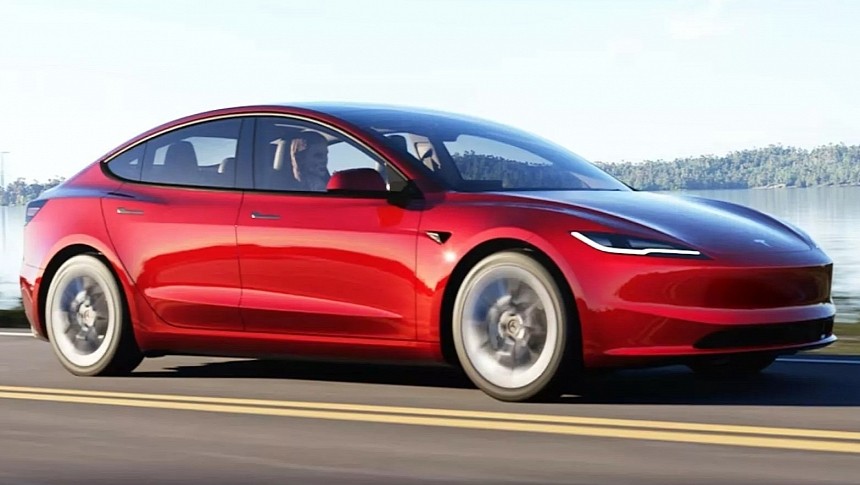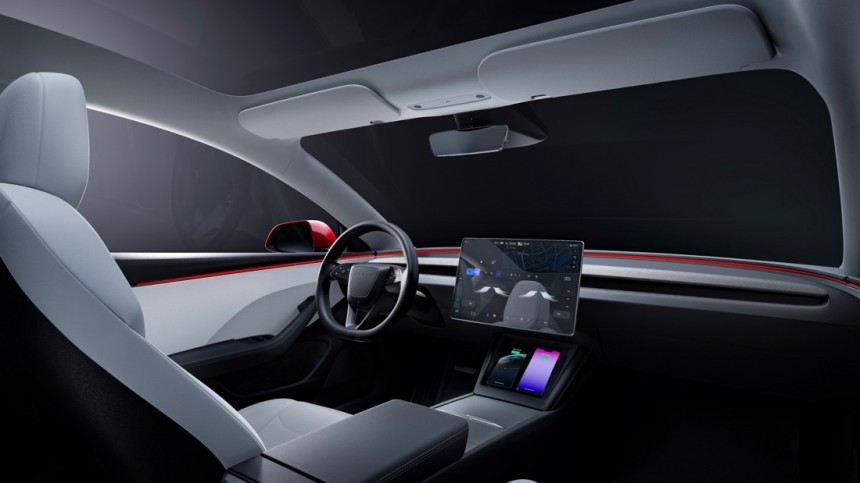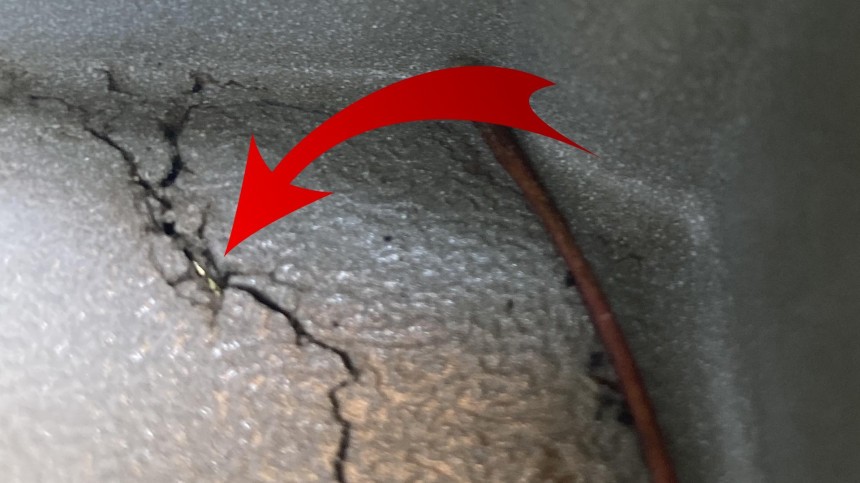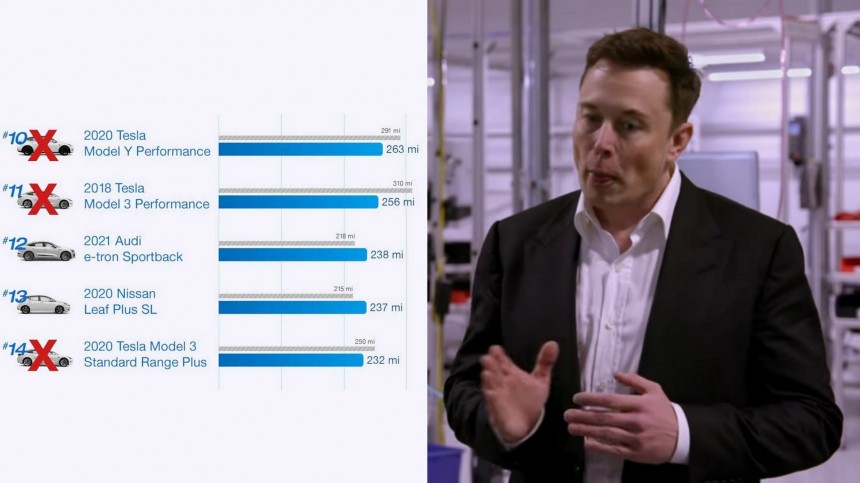Tesla recently reduced the price of Model 3 units in its inventories by $5,500. That was a clear sign that it was preparing to reveal Project Highland, the long-overdue restyling of its most affordable car. Some headlines highlighted the 421-mile (678-kilometer) WLTP range the battery electric vehicle (BEV) maker disclosed, which got me immediately thinking: that is probably the only real improvement the Model 3 received. Was this refresh too little, too late?
Several owners of the previous iteration of Tesla's most affordable vehicle immediately asked where the foglights were. Did they face the same fate as ultrasonic sensors? Some others rushed to clarify they were just moved to the headlights, which makes me wonder how efficient they are in the first place. Foglights are placed very low for a reason: illuminating the ground without much interference from the mist. They are certainly cheaper, which seems to be the main focus of the whole restyling work.
Tesla removed the stalks, giving the Model 3 the same system it incorporated on the Model S and X. Selecting shifts is now something you can only do on the central screen, itself a cost-cutting measure that has already put some drivers in dire straits.
In 2020, the Higher Regional Court in Karlsruhe, Germany, determined that the driver of a Model 3 was to blame when he tried to use the touchscreen. The judges said it was an electronic device – like a tablet or a smartphone – which means it could only be operated while the vehicle was parked, not while driving. The Model 3 driver was just trying to adjust the windshield wiper speed when he hit an embankment and some trees on the evening of March 15, 2019. Luckily, nobody got hurt. The Model 3 Highland concentrated even more functions on that single screen.
The taillights are smaller, simpler, and certainly cheaper to make, but the change that really made me confirm Tesla wants to save money with the Model 3 is the one that apparently did not happen. If it did, Tesla would have shown images and bragged about it. Anyone expecting to see mega castings on the electric sedan will have to wait for the next generation, which allows us to interpret this in several ways.
Considering the Model Y already uses these components and the Cybertruck will follow suit, Tesla could have used Project Highland to also adopt them on the Model 3. Allegedly, that would make it cheaper to manufacture. At the same time, it would require development investments that would only make sense if Tesla planned to sell it for another six years in high volumes. If it didn't, that's either because the BEV maker does not believe it will sell much more or because the vehicle will not take long to die.
Another possible interpretation for that move is that Tesla is not so sure about mega castings. The recent case of a cracked component shows the company has to improve quality control before it scales up that kind of manufacturing solution. That was urgent even before the company developed these massive cast parts, as the lack of a brake fluid reservoir cap demonstrated.
Even the range improvement is debatable. Does anybody believe that after what Reuters recently disclosed? Let me remind you of that story: on July 27, Reuters revealed that Elon Musk ordered all Tesla vehicles to present the best range they could achieve regardless of the conditions.
In cold weather or on mountain roads, the range would be much lower than what the cars disclosed, which led to severe distortions: the accurate range numbers would only appear after half of the charge was gone. Three Tesla customers sued the company soon after the story was published. In the most extreme example, James Porter drove only 92 miles and lost 182 miles of range in his 2022 Tesla Model Y Performance, a car that has an official EPA range of 303 miles.
If the Model 3 could really drive 421 miles on a full charge, it would beat the Model S as Tesla's vehicle with the most extended range, even in the WLTP cycle (634 km, or 394 mi). Tesla itself talks about only 629 km (391 mi) on its pages, which already show the Model 3 Highland. Did it update only the pictures and not the data? However, it is important to stress that this range was established under the WLTP cycle, considered much more generous – and distant from reality – than the EPA cycle. Ironically, it is also a more trustworthy comparison parameter.
As I have discussed here before, the Environmental Protection Agency (EPA) allows automakers to test their cars under two testing procedures. The standard method submits the vehicles to a road cycle, an urban cycle, and applies an adjustment factor to them that cuts the range by 30%. Those willing to have a more generous adjustment factor can select an optional five-cycle testing procedure. That immediately prevents a fair comparison between the numbers obtained by each method. To make matters worse, the automakers perform these tests and present them to EPA. The agency has already ordered Tesla to reduce some numbers after auditing them.
Summing up, what Tesla did for its former best-seller was not enough to make its sales recover. It mostly made it cheaper to manufacture, with very little investment to pretend it was something new. Some Tesla advocates are even evoking Volkswagen's example with the original Beetle to defend the Model 3 strategy. They ask: "Have you seen it change that much?" No, the Beetle died without substantial changes almost seven decades after being introduced. If that is the plan for the Model 3, we may see too little for a long time.
Tesla removed the stalks, giving the Model 3 the same system it incorporated on the Model S and X. Selecting shifts is now something you can only do on the central screen, itself a cost-cutting measure that has already put some drivers in dire straits.
In 2020, the Higher Regional Court in Karlsruhe, Germany, determined that the driver of a Model 3 was to blame when he tried to use the touchscreen. The judges said it was an electronic device – like a tablet or a smartphone – which means it could only be operated while the vehicle was parked, not while driving. The Model 3 driver was just trying to adjust the windshield wiper speed when he hit an embankment and some trees on the evening of March 15, 2019. Luckily, nobody got hurt. The Model 3 Highland concentrated even more functions on that single screen.
Considering the Model Y already uses these components and the Cybertruck will follow suit, Tesla could have used Project Highland to also adopt them on the Model 3. Allegedly, that would make it cheaper to manufacture. At the same time, it would require development investments that would only make sense if Tesla planned to sell it for another six years in high volumes. If it didn't, that's either because the BEV maker does not believe it will sell much more or because the vehicle will not take long to die.
Another possible interpretation for that move is that Tesla is not so sure about mega castings. The recent case of a cracked component shows the company has to improve quality control before it scales up that kind of manufacturing solution. That was urgent even before the company developed these massive cast parts, as the lack of a brake fluid reservoir cap demonstrated.
In cold weather or on mountain roads, the range would be much lower than what the cars disclosed, which led to severe distortions: the accurate range numbers would only appear after half of the charge was gone. Three Tesla customers sued the company soon after the story was published. In the most extreme example, James Porter drove only 92 miles and lost 182 miles of range in his 2022 Tesla Model Y Performance, a car that has an official EPA range of 303 miles.
If the Model 3 could really drive 421 miles on a full charge, it would beat the Model S as Tesla's vehicle with the most extended range, even in the WLTP cycle (634 km, or 394 mi). Tesla itself talks about only 629 km (391 mi) on its pages, which already show the Model 3 Highland. Did it update only the pictures and not the data? However, it is important to stress that this range was established under the WLTP cycle, considered much more generous – and distant from reality – than the EPA cycle. Ironically, it is also a more trustworthy comparison parameter.
Summing up, what Tesla did for its former best-seller was not enough to make its sales recover. It mostly made it cheaper to manufacture, with very little investment to pretend it was something new. Some Tesla advocates are even evoking Volkswagen's example with the original Beetle to defend the Model 3 strategy. They ask: "Have you seen it change that much?" No, the Beetle died without substantial changes almost seven decades after being introduced. If that is the plan for the Model 3, we may see too little for a long time.































